I encounter Diana Sofia Lozano’s work in our present moment, which is dominated by virality. The fear of viral matter — in the air, in the grocery store, in our friends — and the unknowability of its spread make us retreat into isolated spaces. There is worthwhile safety in this antiseptic seclusion, although it is lonely. In our viral age, luxury is not only decadence but the ability to distance oneself from dirt.
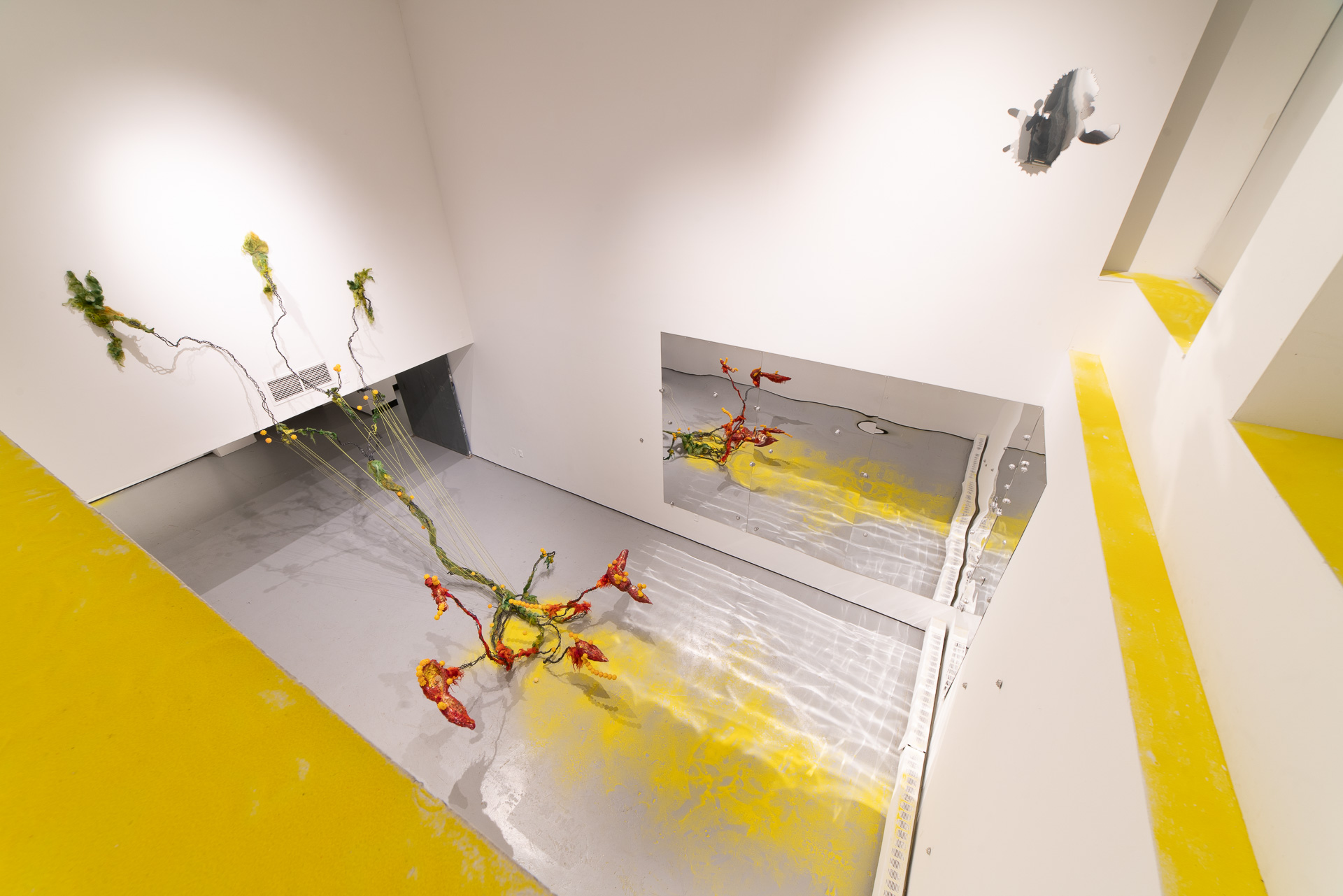
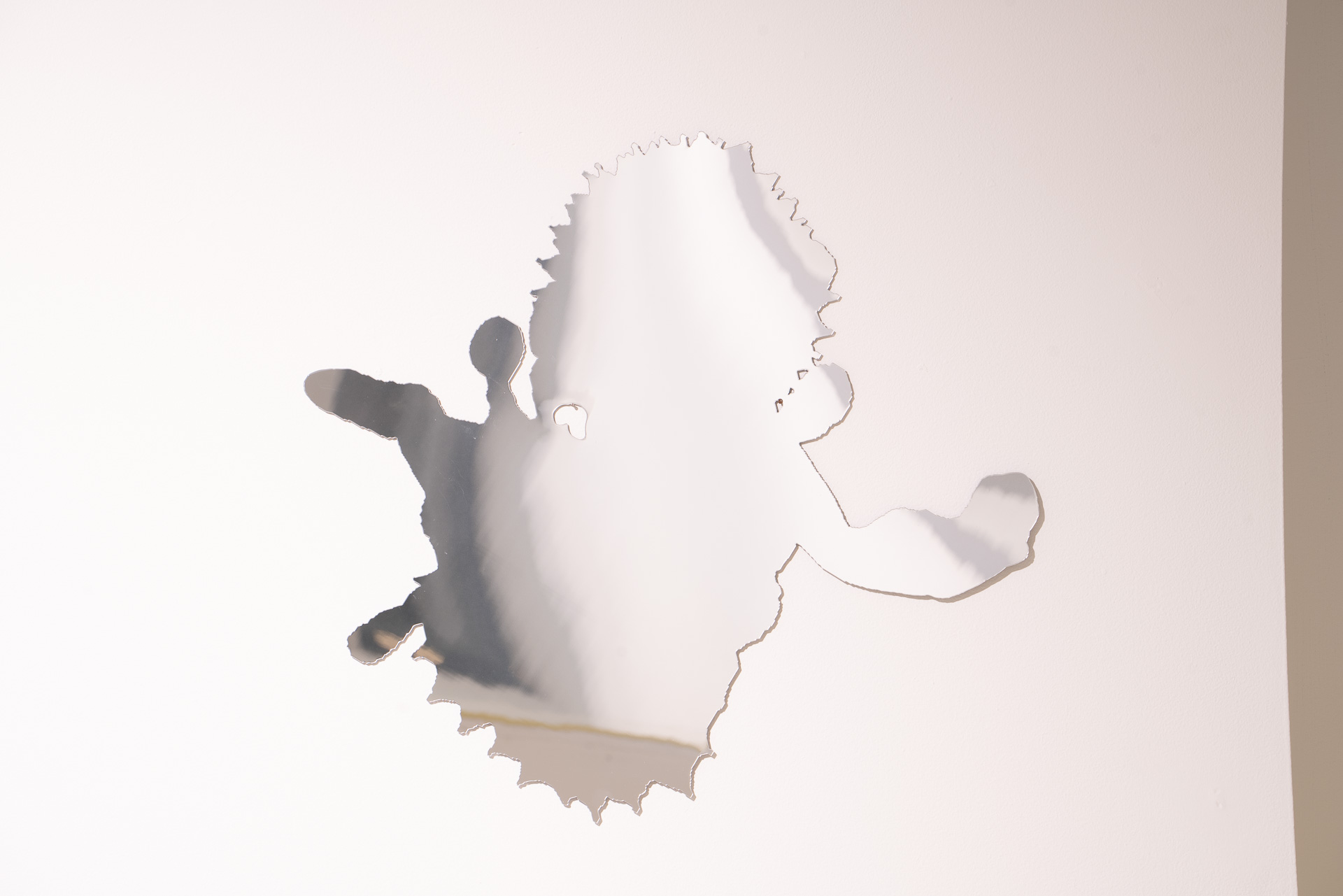
Lozano asks us to reconsider the ethics of dirt, of seepage, of slime, fluid, and rot. Where her work resides, in the botanical world, luxury and dirt are not antonyms. Braided armatures of hardened steel are woven through with mossy and dreaded wools. Sifted on the ground is a residue that conjures sweet pollen the color of honeysuckle; in a different light, it takes on the harshness of sulfur. Suspended at the tips of the sculpture’s steel arms are open boats — “pods” — that carry pollinic forms and an unknown, unctuous substance that smells of piña colada and garden dirt, like sick earth. Here is a sticky deliverance, an offering.
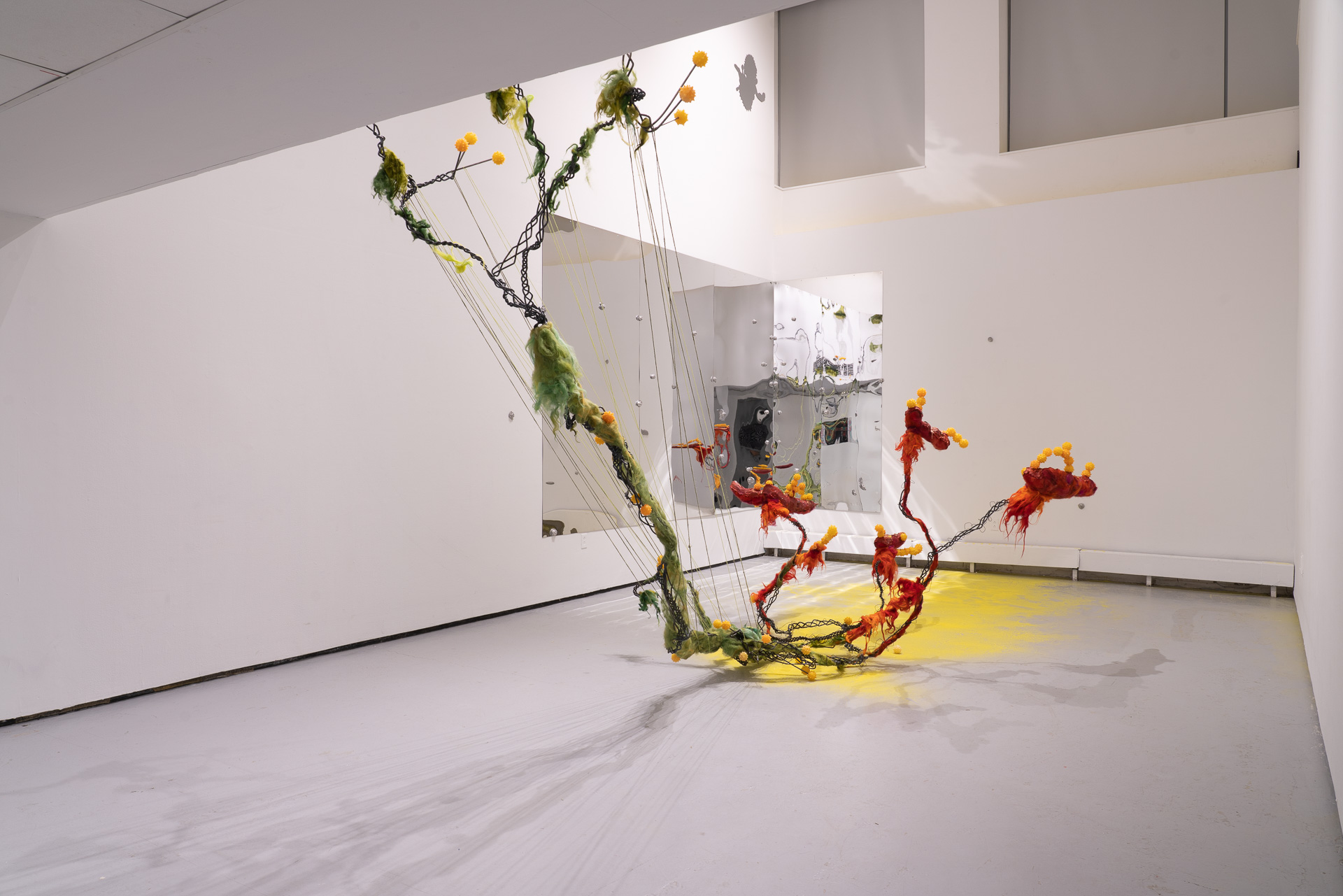
Where can you find this plant but here? Not in Linnaeus’ Species Plantarum, where 6,000 botanical species come into unfamiliar names, a taxonomical regulation of colonial design. Do not dare name it. The bent steel, wools, and sludgy admixture, its sap, slip between these narrow nomenclatures. If it discomfits you, that’s the point. Naming is an act of enclosure. Botanical taxonomy — the nomenclature we use to make the world of plants legible through spoken and written languages — is the product of violent colonial expedition under the pursuit of European Enlightenment. These “voyages of discovery” from the sixteenth to the nineteenth centuries produced a new botanical science in the deathly pursuit of capital. Imagining plants from stolen archipelagoes to be profitable, colonizers extracted and intentionally distorted indigenous knowledges of these plants for their gain, naming them as a means of owning them.1 These are the names we have inherited.
1 O’Donnell, Rachel. “Imperial Plants: Modern Science, Plant Classification and European Voyages of Discovery.” Graduate Journal of Social Science.a Vol. 7 Issue 1 (2010): 59–72.
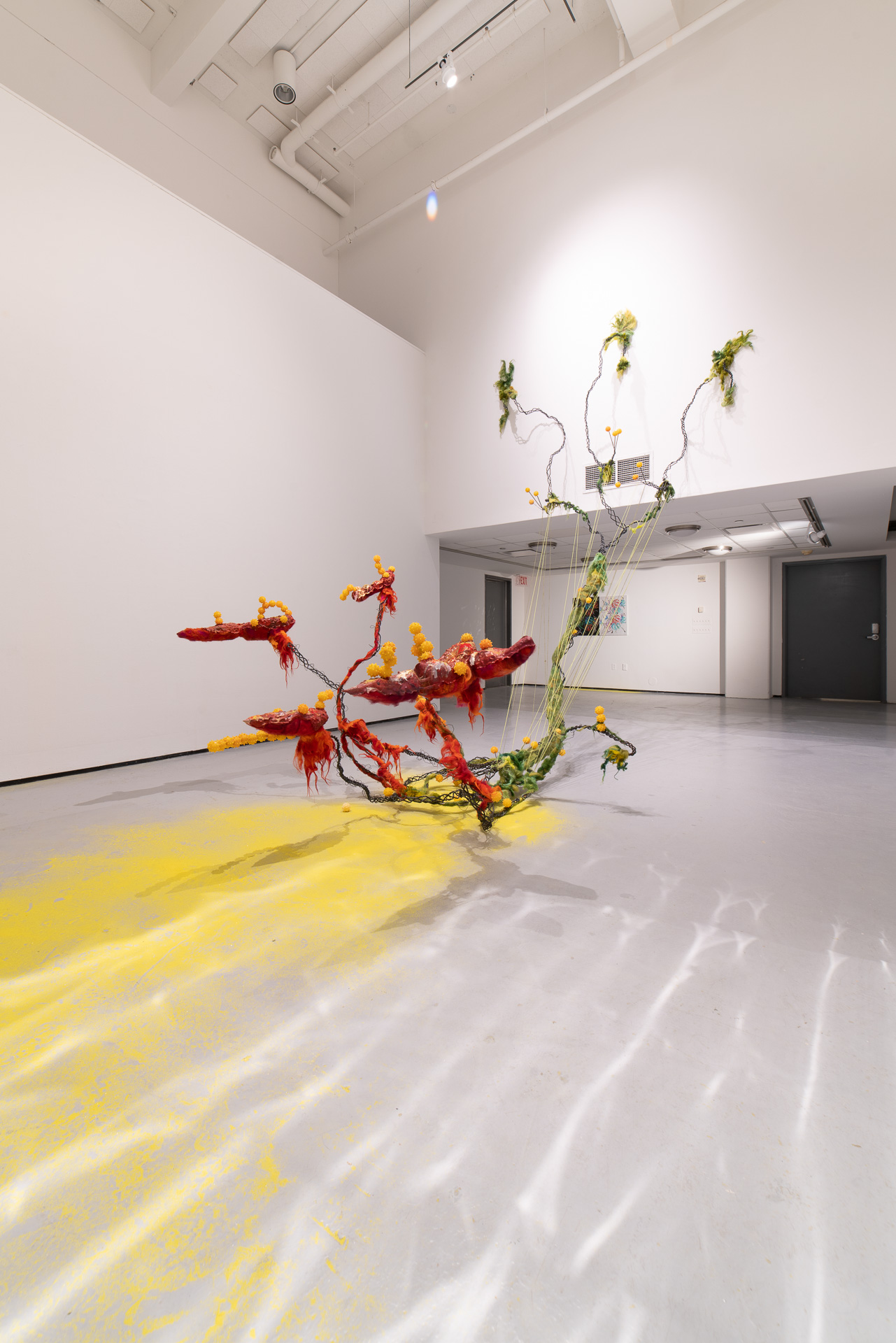
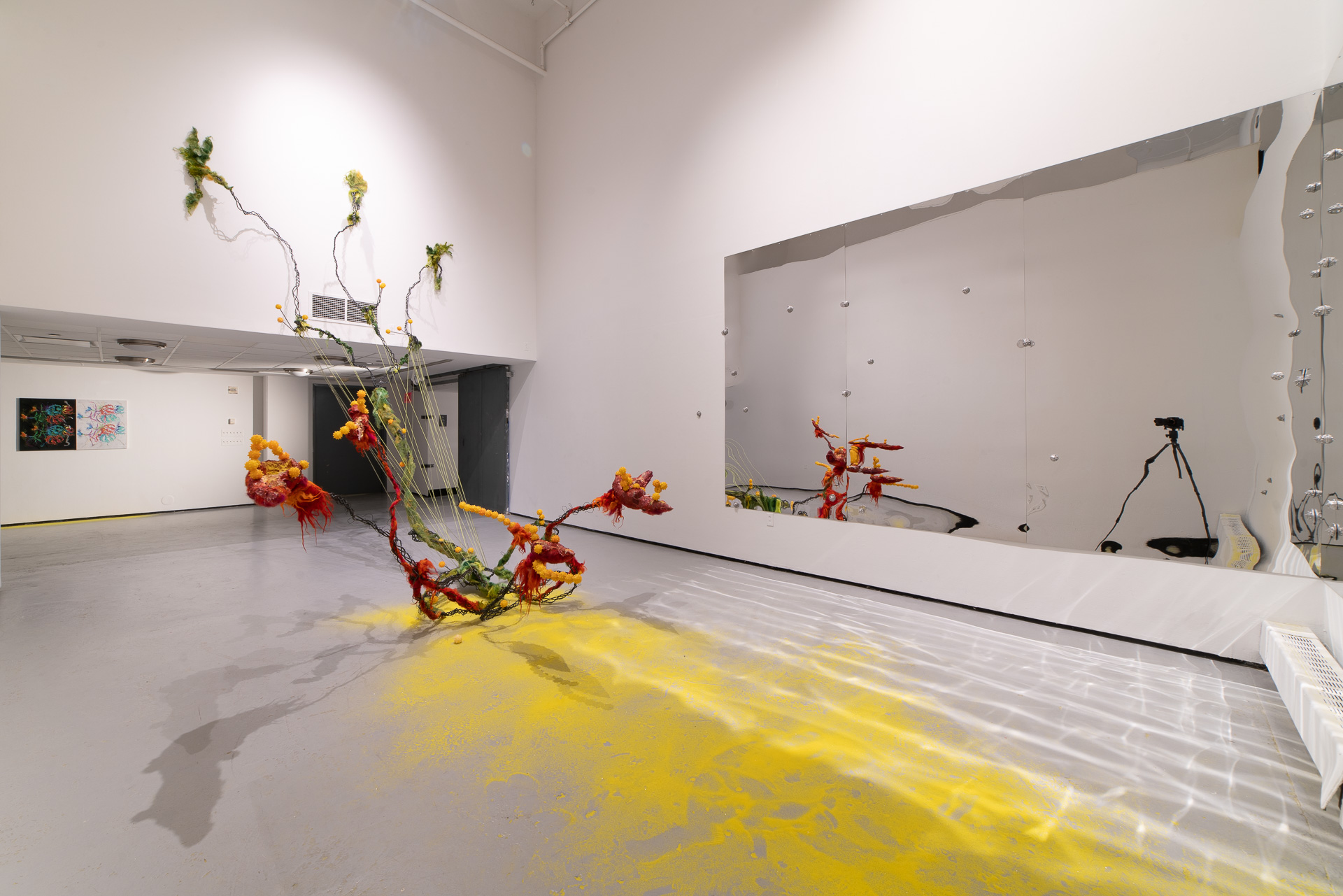
In the space of Lozano’s creation, this plant has no roots, or if it does, they are not dug into the earthen ground, resting instead firmly on the cement gallery floor, as though they had been yanked from the soil for closer inspection by human eyes.
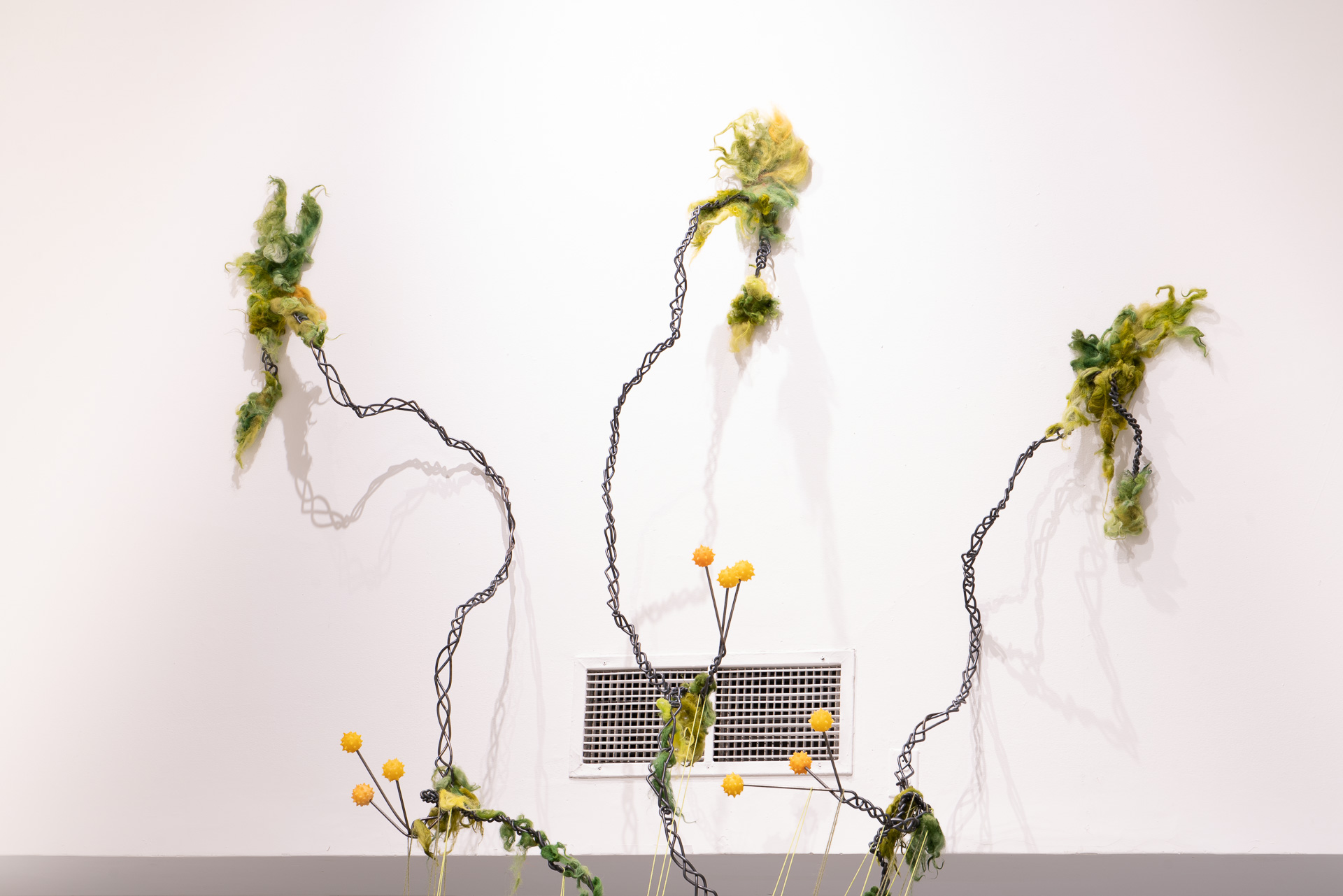
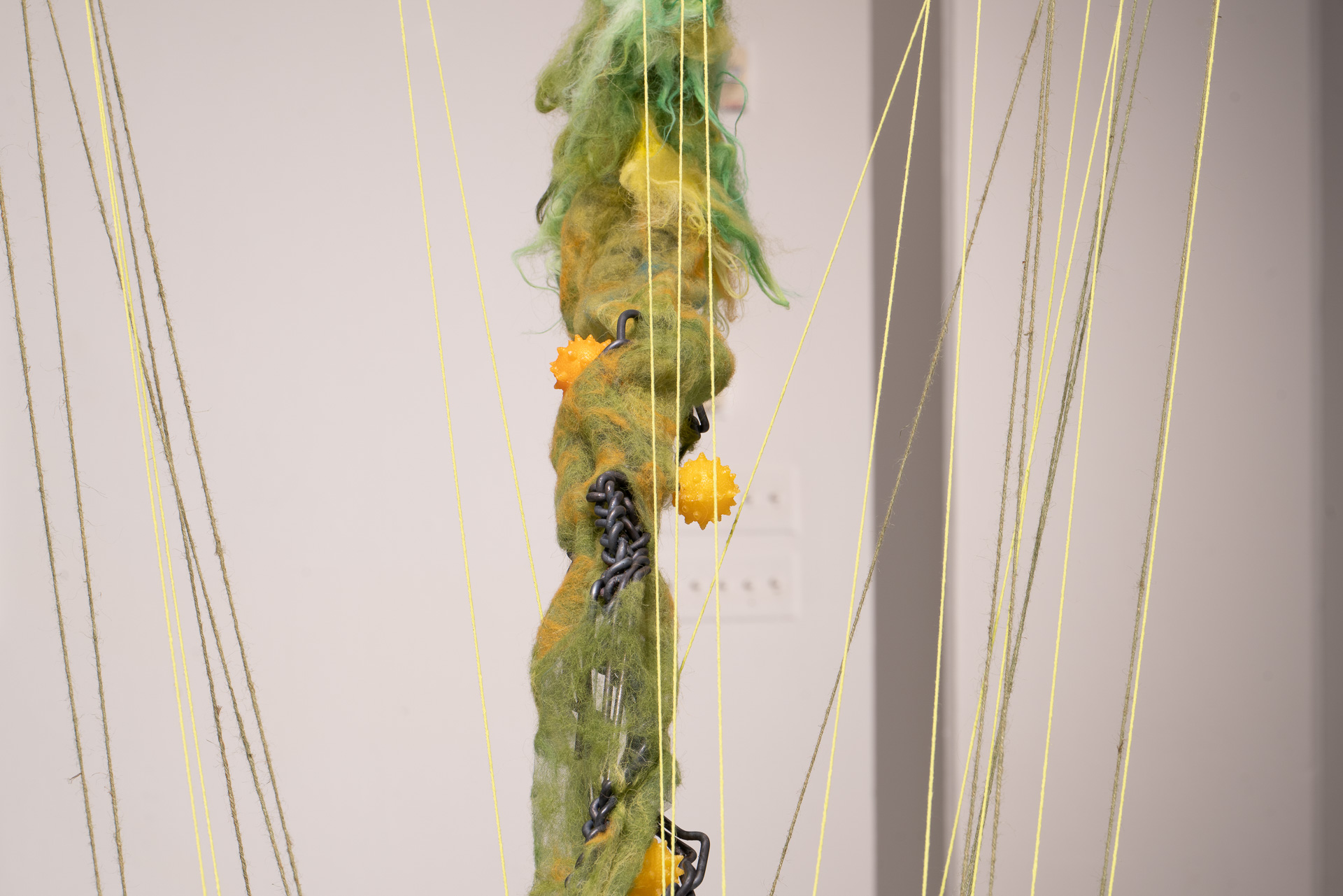

Its uprootedness, an everyday violence in the world of plants, recalls that much of botanical illustration has been rendered using “herbarium specimen,” where the species is, in fact, already dead, revitalized only through the clever imagination of the illustrator. Killing for the function of naming raises the stakes of botanical imagery to more than an innocent sport, akin to dressing up a cadaver.
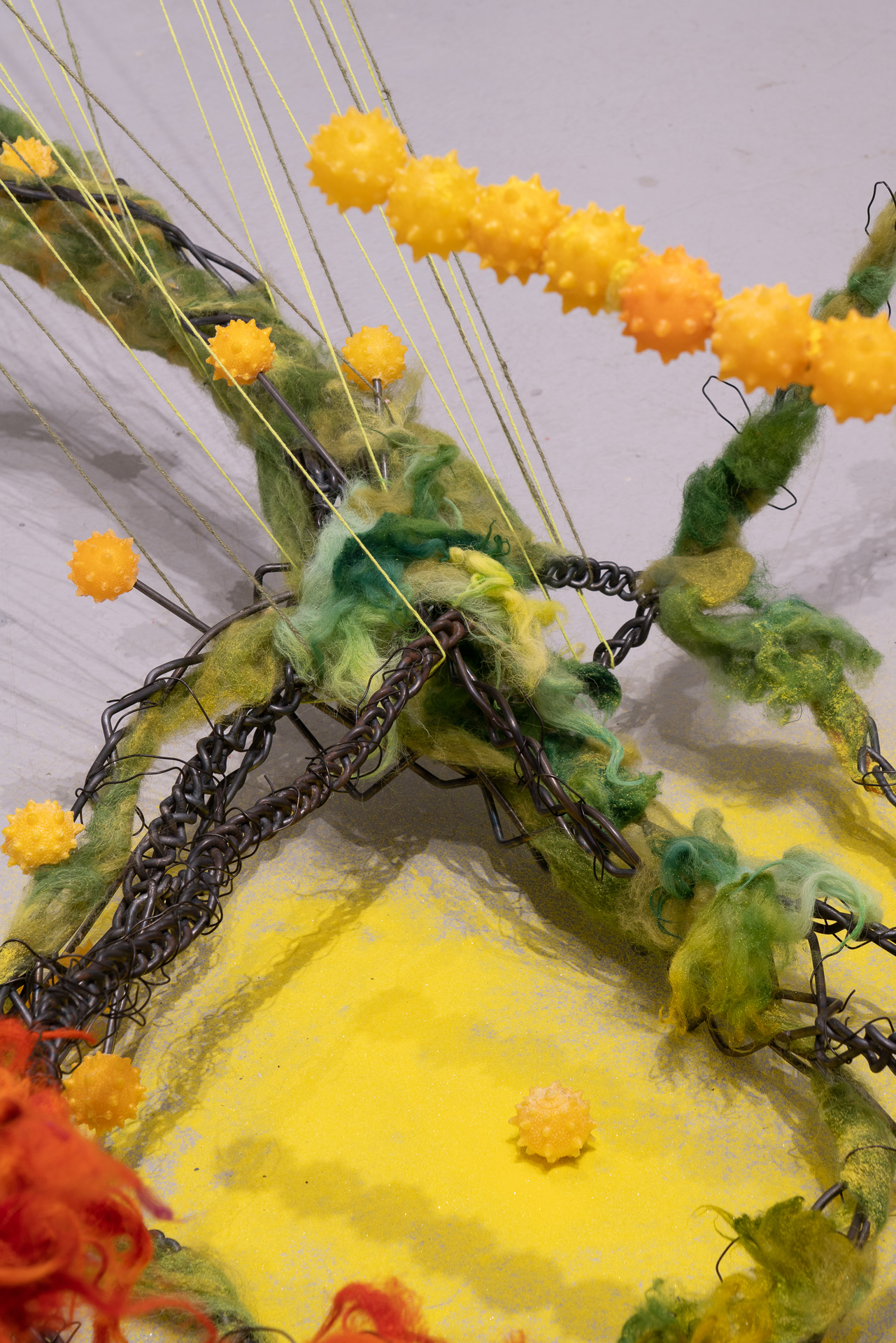
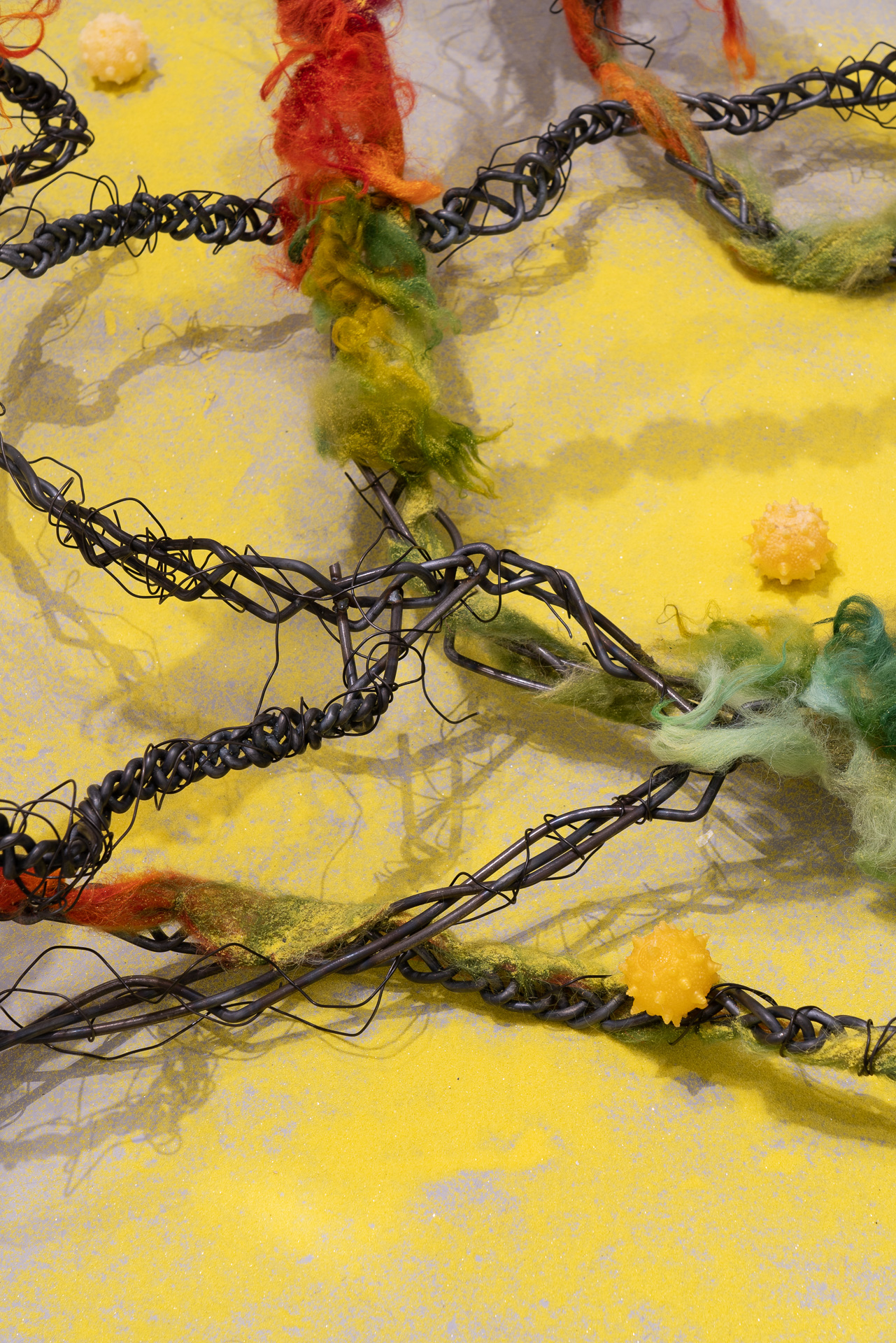
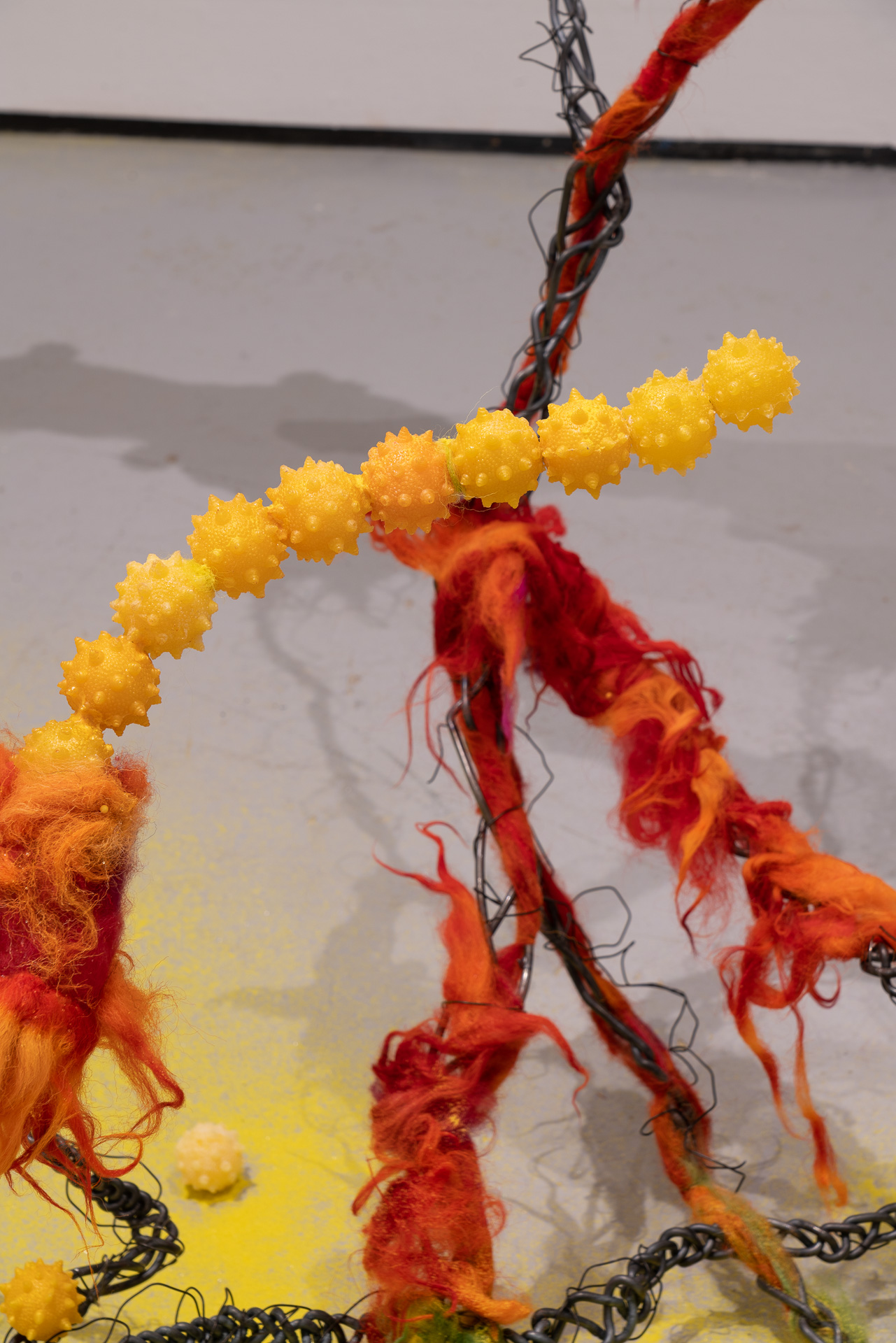
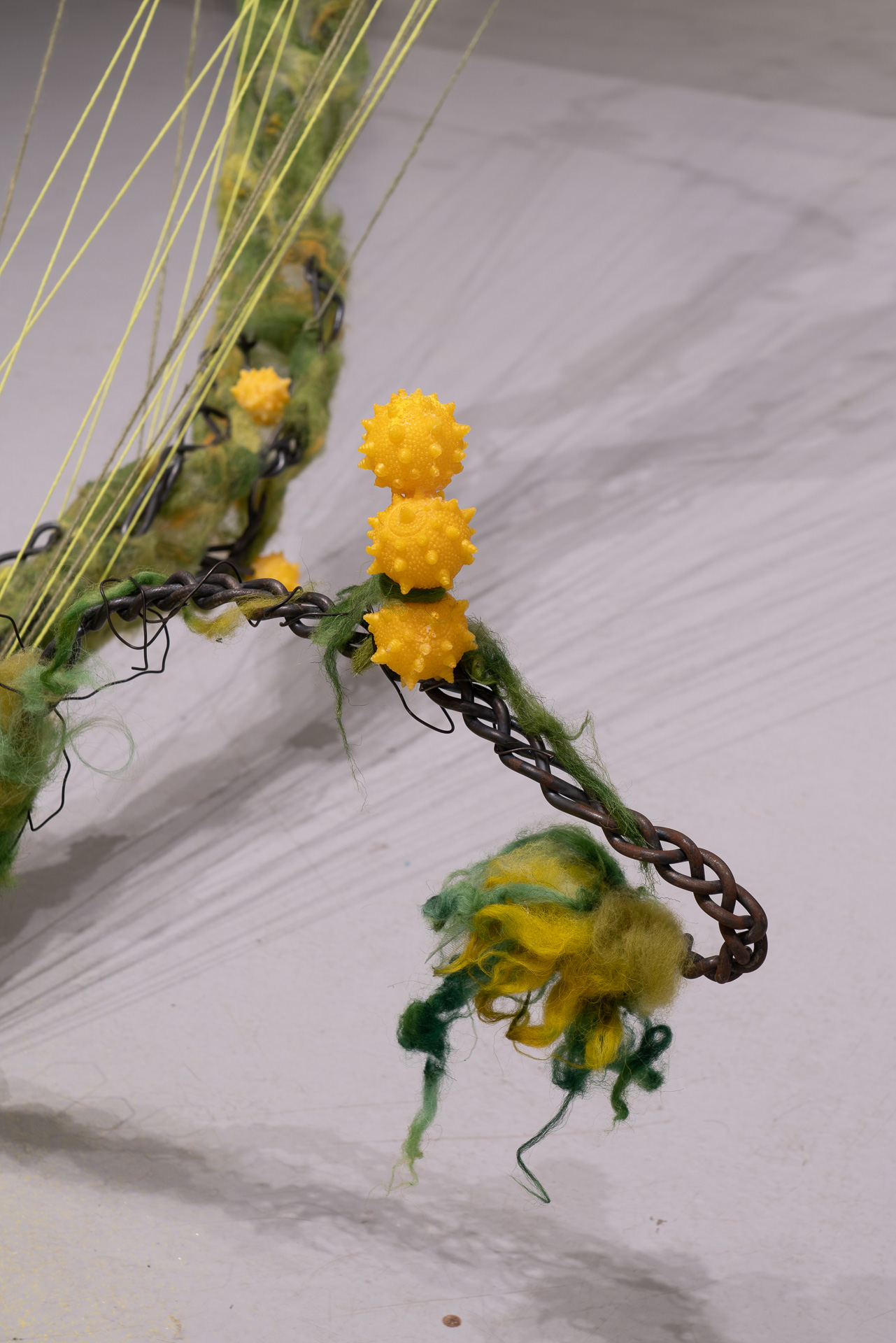
The plant’s solitary isolation in the gallery recalls the formal qualities of botanical illustrations themselves, where plants named for European men2 are rendered as austere black-and-white diagrams, stems, leaves, and flowering buds hovering against a blank white background. In the pursuit of “scientific accuracy” and rationalized “neutrality,” these technical drawings redact all trace of the ecology in which plants grow. Other ways of knowing these plants — the delicate smell of nectar secretion, or the numbing touch of a plant’s downy hairs — are ecosocial intimacies rendered marginal next to the privileged modality of “seeing.”
2 Linneaus wrote that botanists have the: “religious duty to engrave the names of men on plants, and so secure for them immortal renown” (Schiebinger, Londa. “Feminist History of Colonial Science.” Hypatia, 19(1), (2004): 233-254. doi:10.1111/j.1527-2001.2004.tb01276.x.)
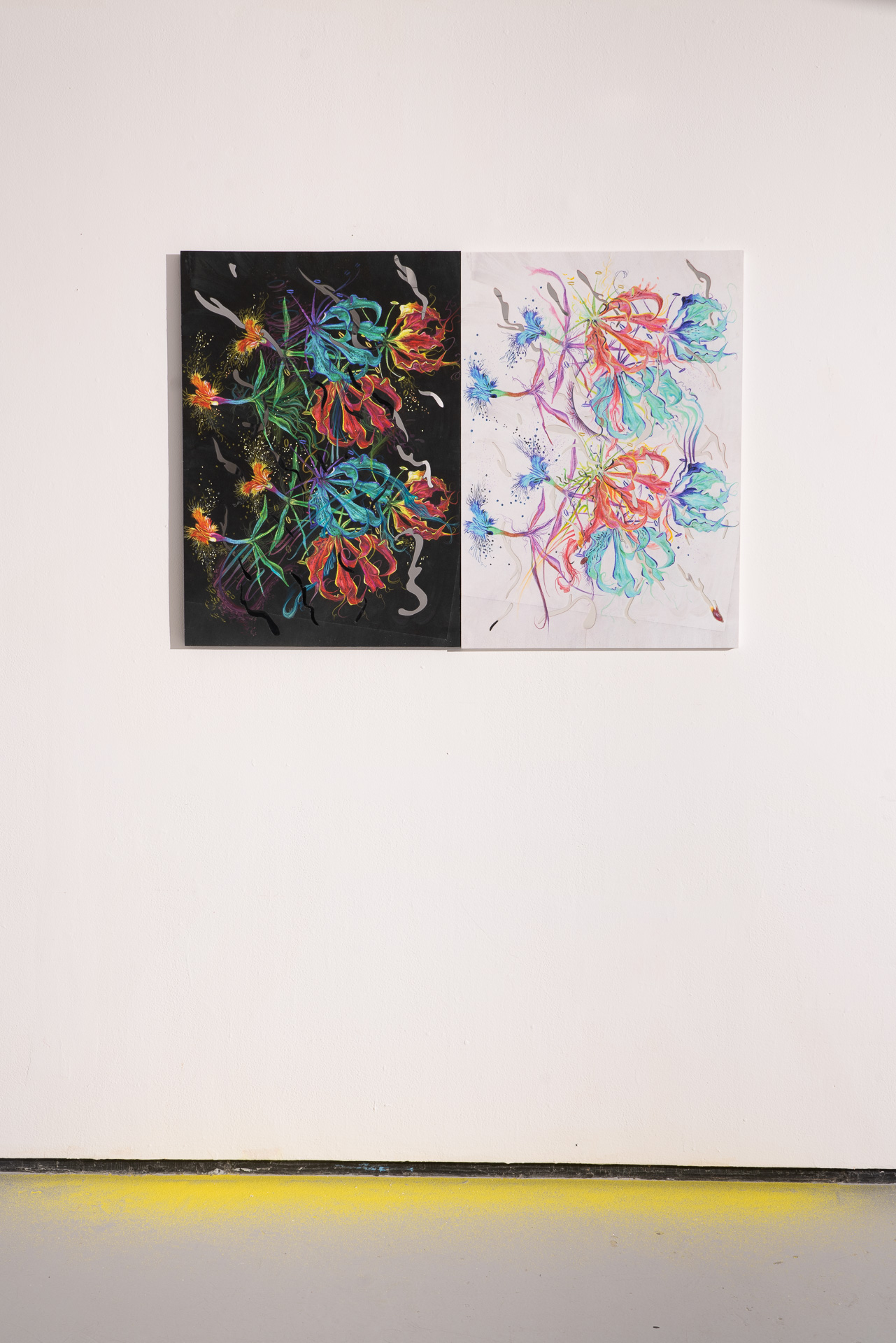
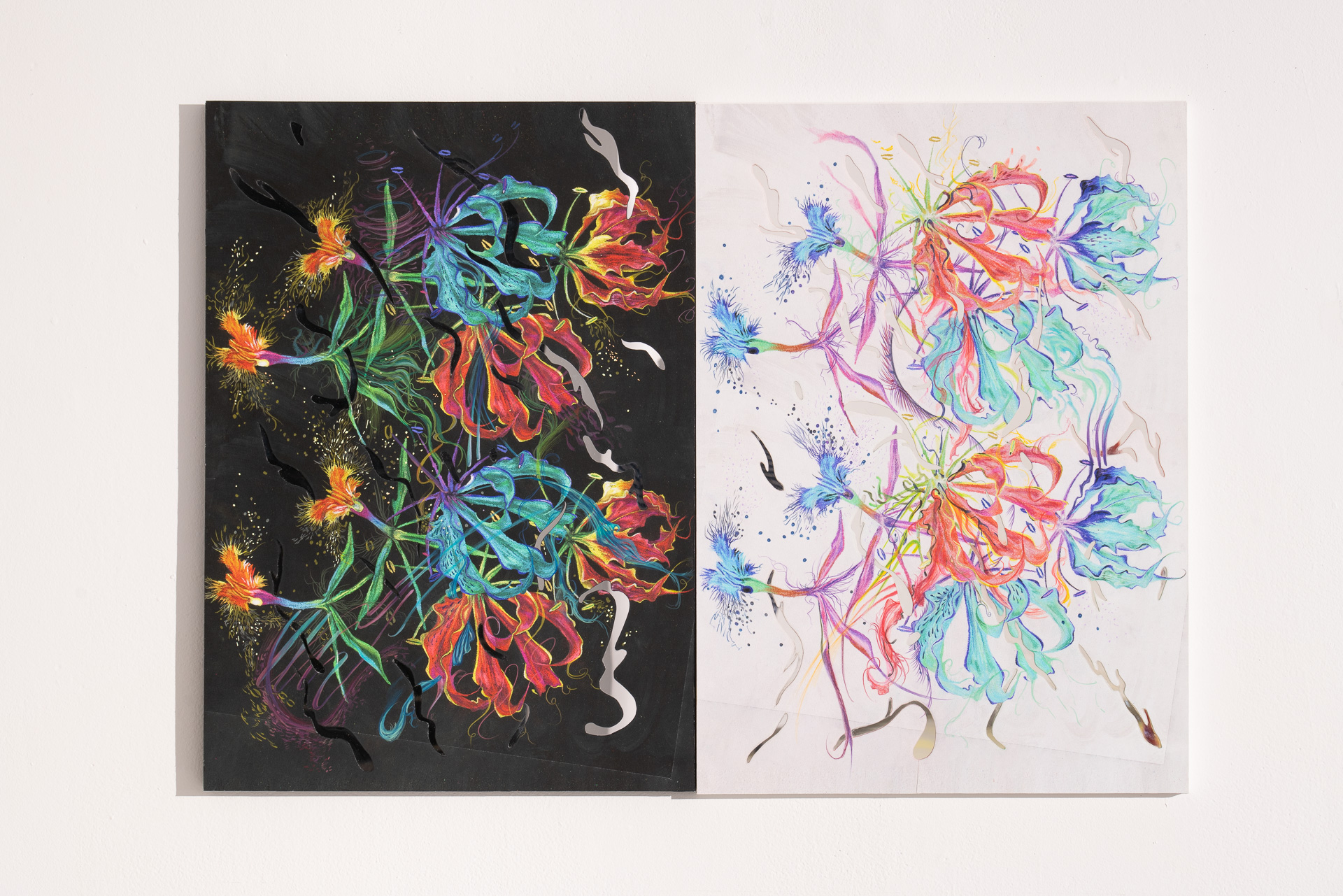
Our implication in the work is unstable, slippery, not unlike the dewy fluid that runs down the spine of a plant. The sculpture overtakes any viewer who encounters it, destabilizing any prior assumptions about scale. Has the plant been magnified or have we shrunk down? At this new resolution, what becomes clearer? The feeling of being dwarfed by this encounter is intensified as the viewer confronts a wall of mirrors. By refracting the body infinitely across the room, the viewer is dispersed like a virus, like a vine, like a dandelion weed making one million more of itself. The pollen is no longer richly yellow but a chrome-polished mirror, fracturing a formerly clear reflection of self.
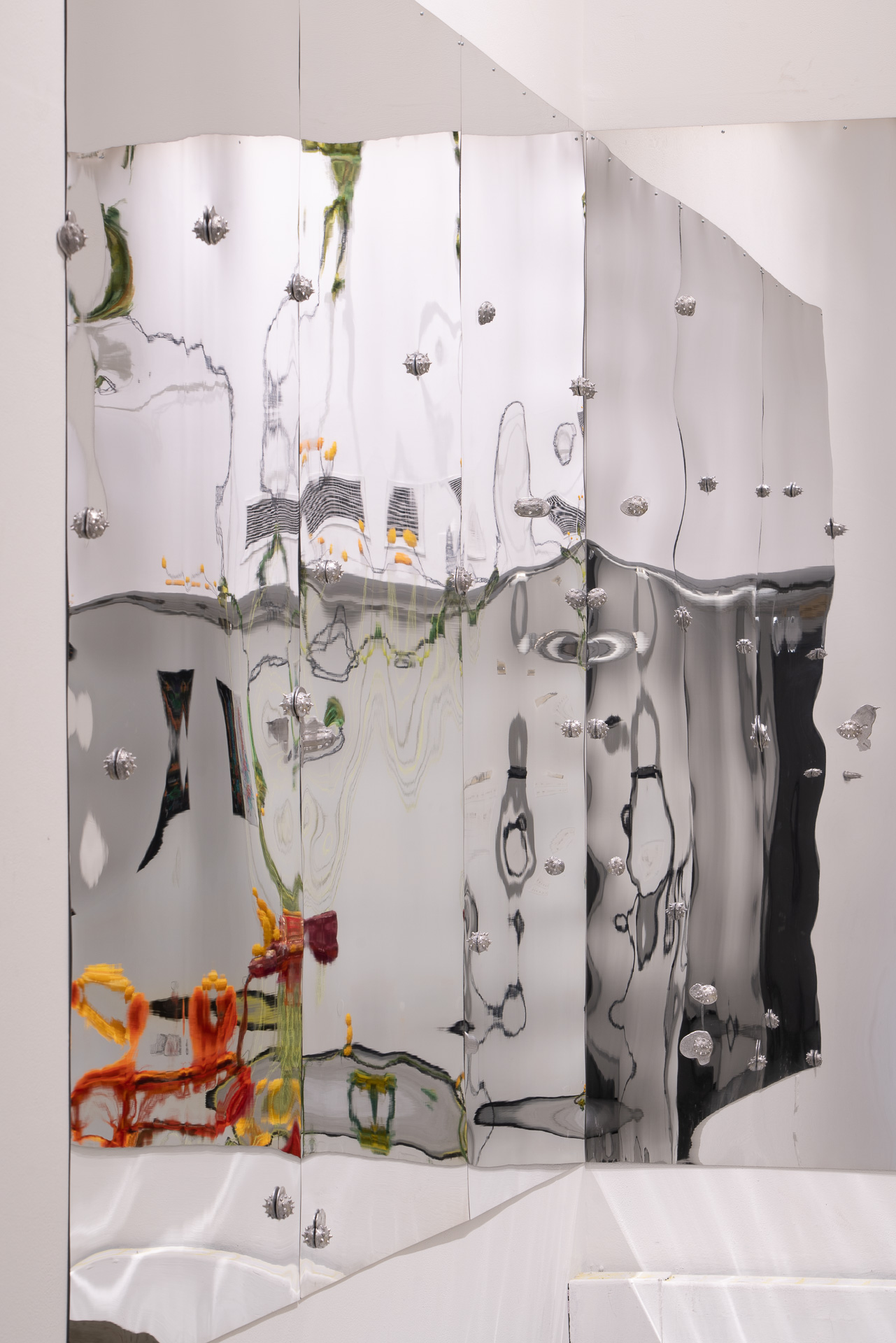
Escape the anthropocentric hidden in our acts of naming; teach us a looking that does not collide with the limits built into the logic of our language. What acts would a flower use to name itself in lieu of words? We know our syllables don’t unfold with our multitudes, they can’t re-link to fit what we are yet to grow into; they stop short in time.
* Parallel Botany, Leo Lionni.

I’m carried off to the ineffable on the extension of these oozing ligatures, their meshed textures and colors. Does reaching reveal intention? Desire? Bright colors bring pollinators, initiate dissemination. These beings claim no home turf; the garden houses only the invasive. Left to its own devices it seethes at us in all the ways proliferation pervades atmosphere; leaky fluids and the vapors of overripe sweetness choose dispersal over confinement in physical shape.
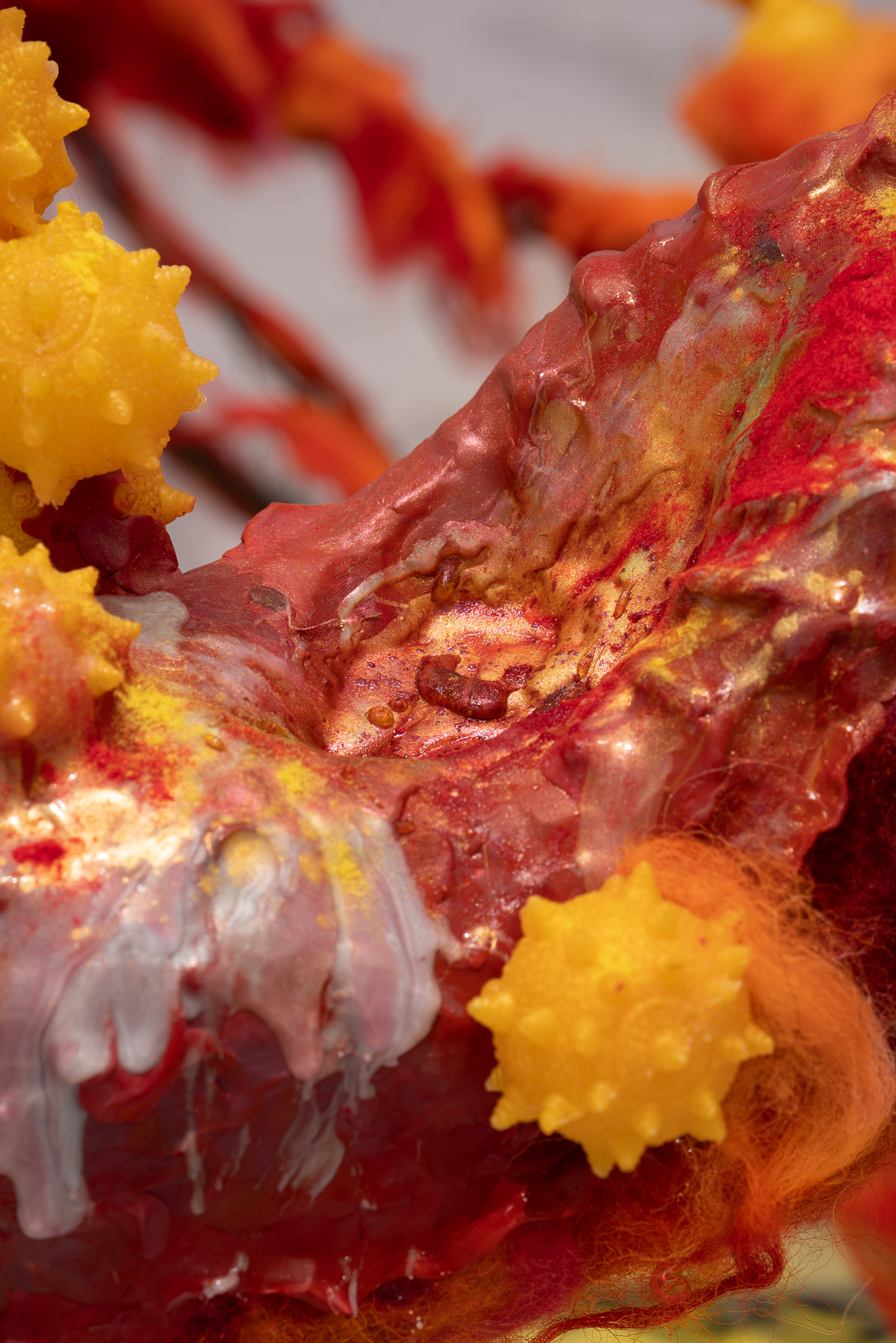


Their generative moves might reach out to grow through us too or drop spores into our deepening ground. We are not necessary but we present another opportunity for these structures to fulfill their need to vary. That mingled whiff of sweet earth and skin beckons us like bees to bright petals. Whether soil-rooted or white-cubed, flora need a way to bring us close, to enlist us in their ongoing dispersal. Their adaptations stem from an evolving expertise in capturing other lifeforms.
3 Anne Carson, “Losing the Edge” from Eros the Bittersweet, pg. 40.
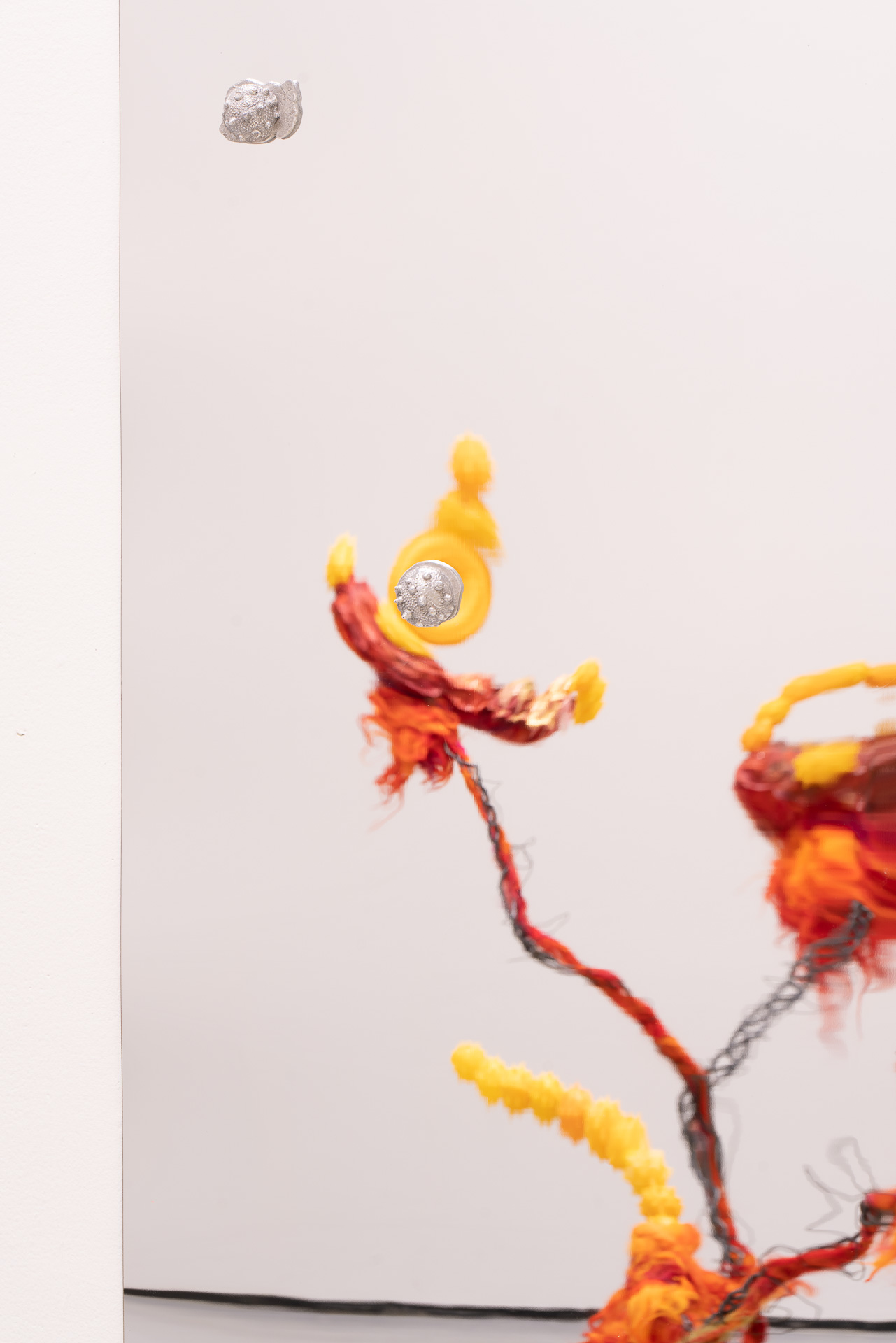
This knowledge is draped over, dragged along the object’s development: a braided longevity that keeps excess in the third strand of a double helix. These materials do not meld so much as they conjoin, confront, come to a head with each other, and interweave resources of various space. Unresolved alloys keep difference visible at close quarters; it is a hyphenated invention, a proliferation of dashes between an increasing array of materials, and the promise of wider gathering to come.
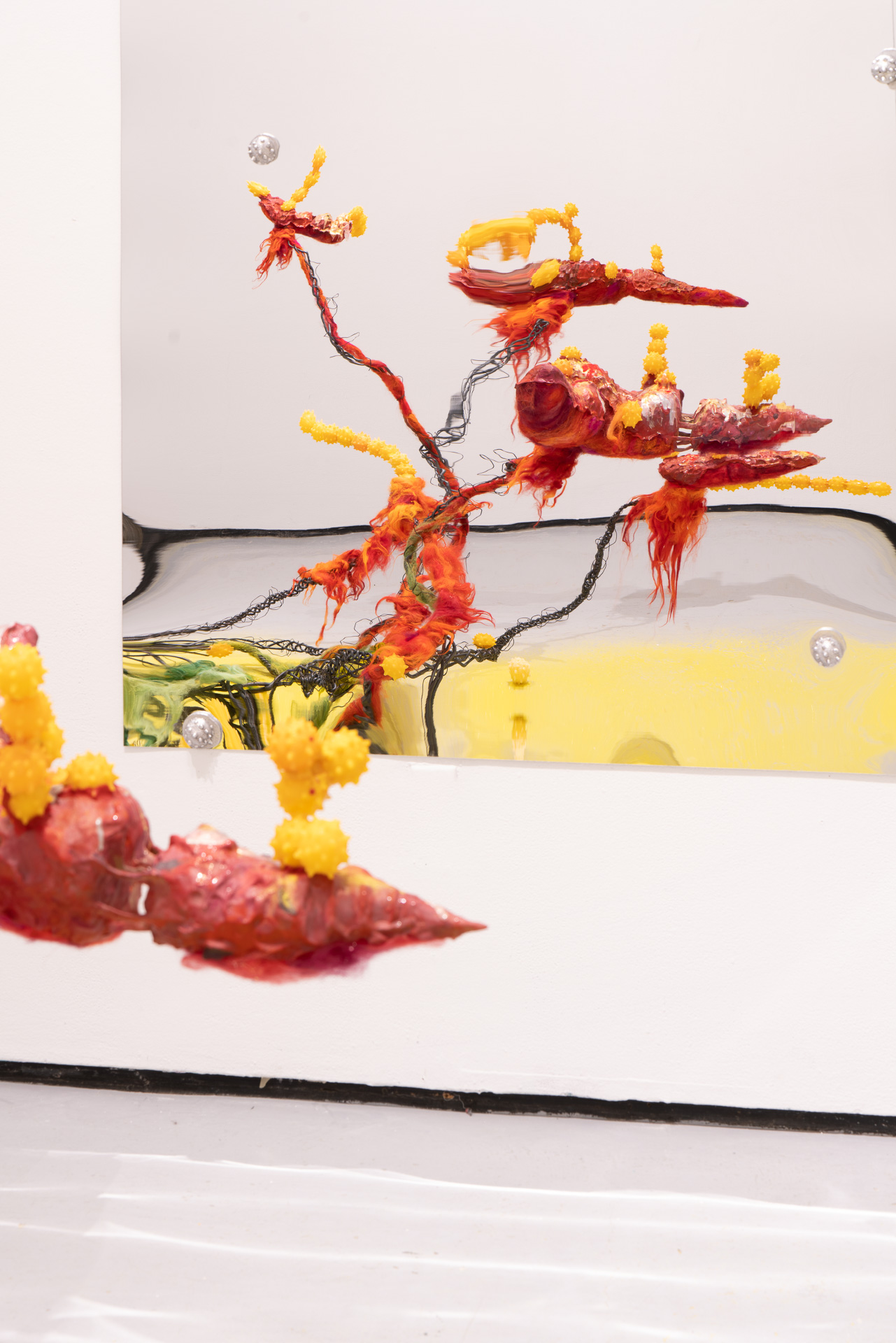
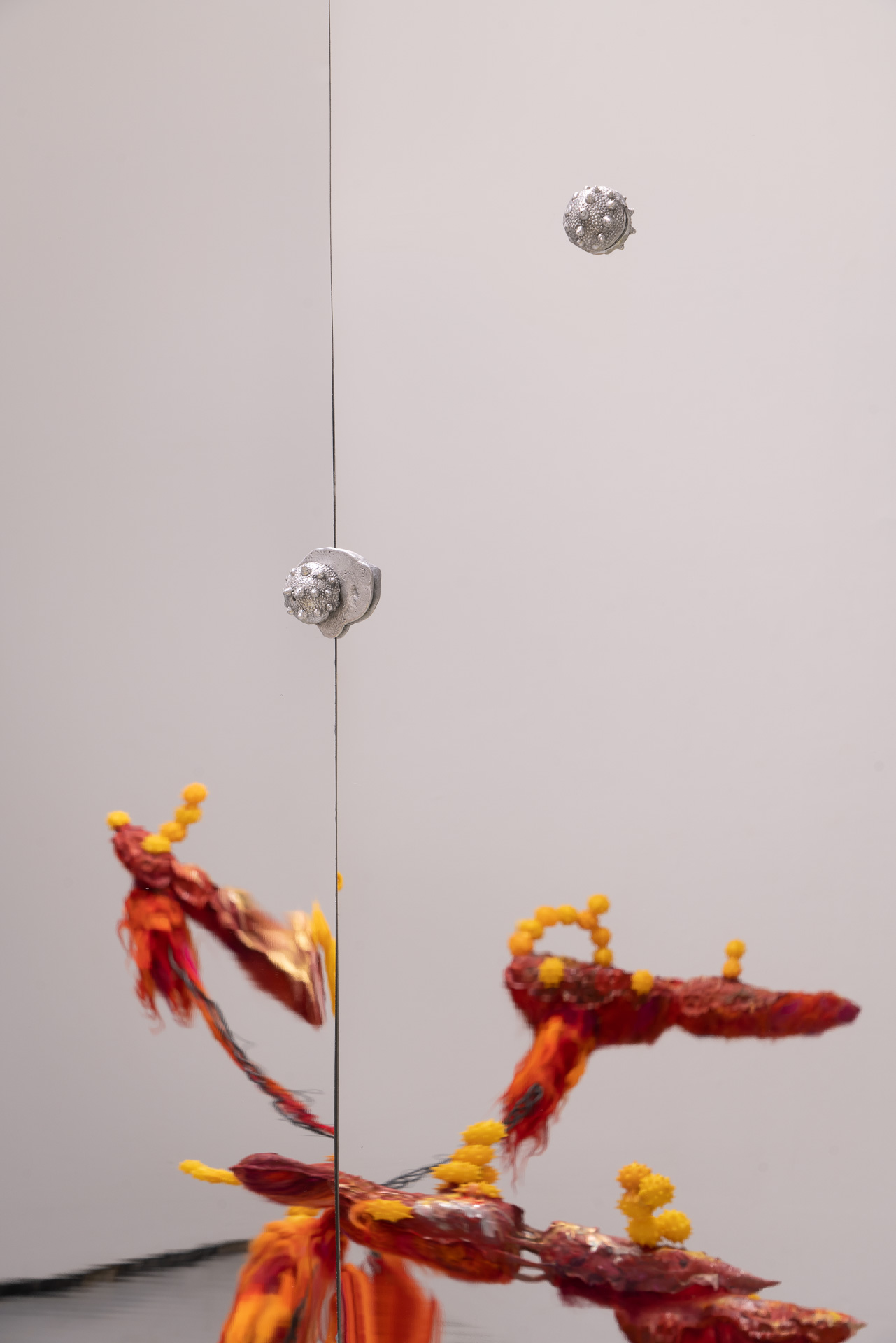
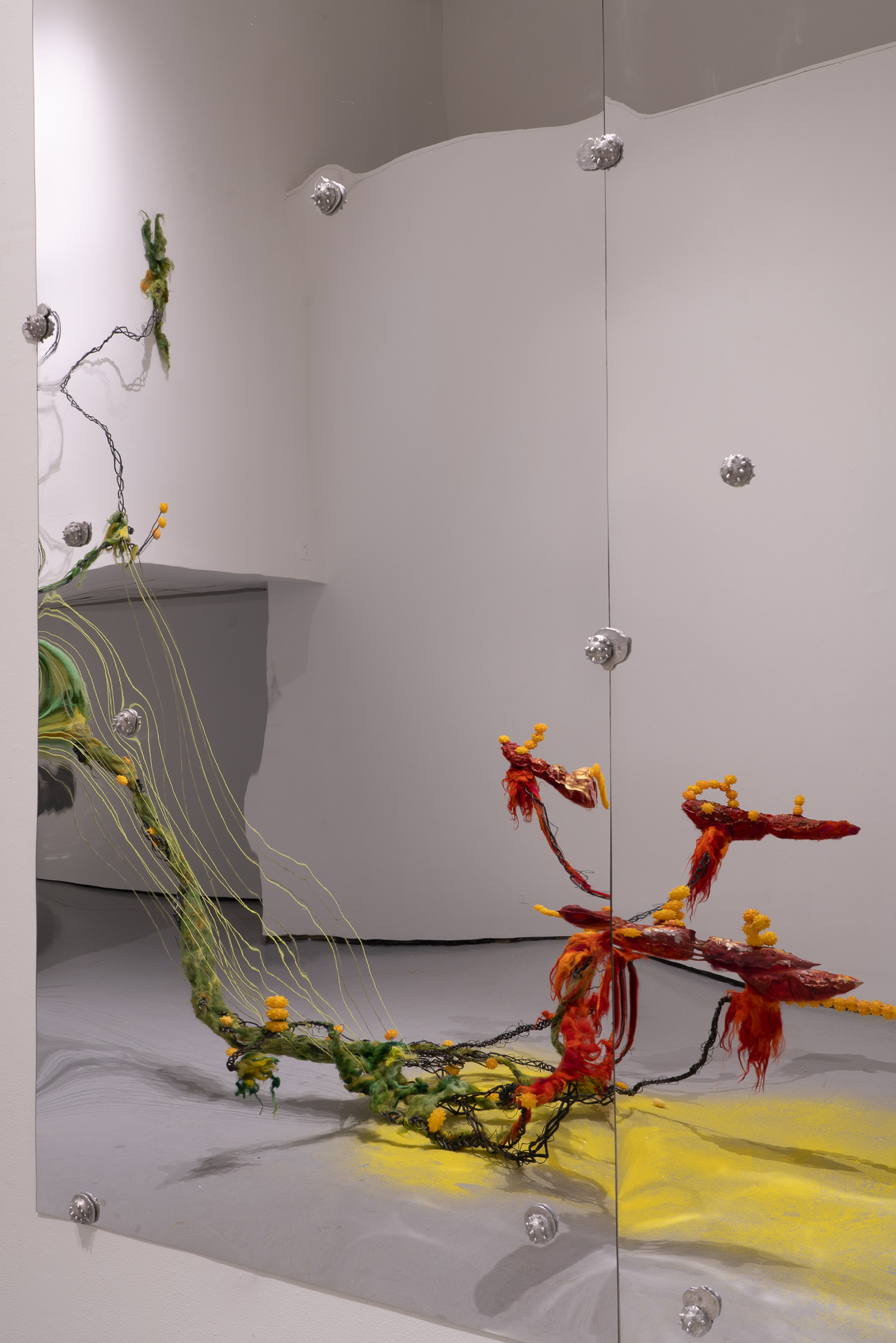
Is there a non-anthropocentric way to explore intimacy or establish kinship? It might help to start from their need. We can catalog to a bestiary of possible carriers, if we let our questions give way to want. How we see may admit or require distance, but the haptics of smell and leakage offer more troubling presence, the lacquer dripping off these mouths makes me want to touch. Here the boundary between invitation and interdiction, stillness and vibrance, gets fuzzy.
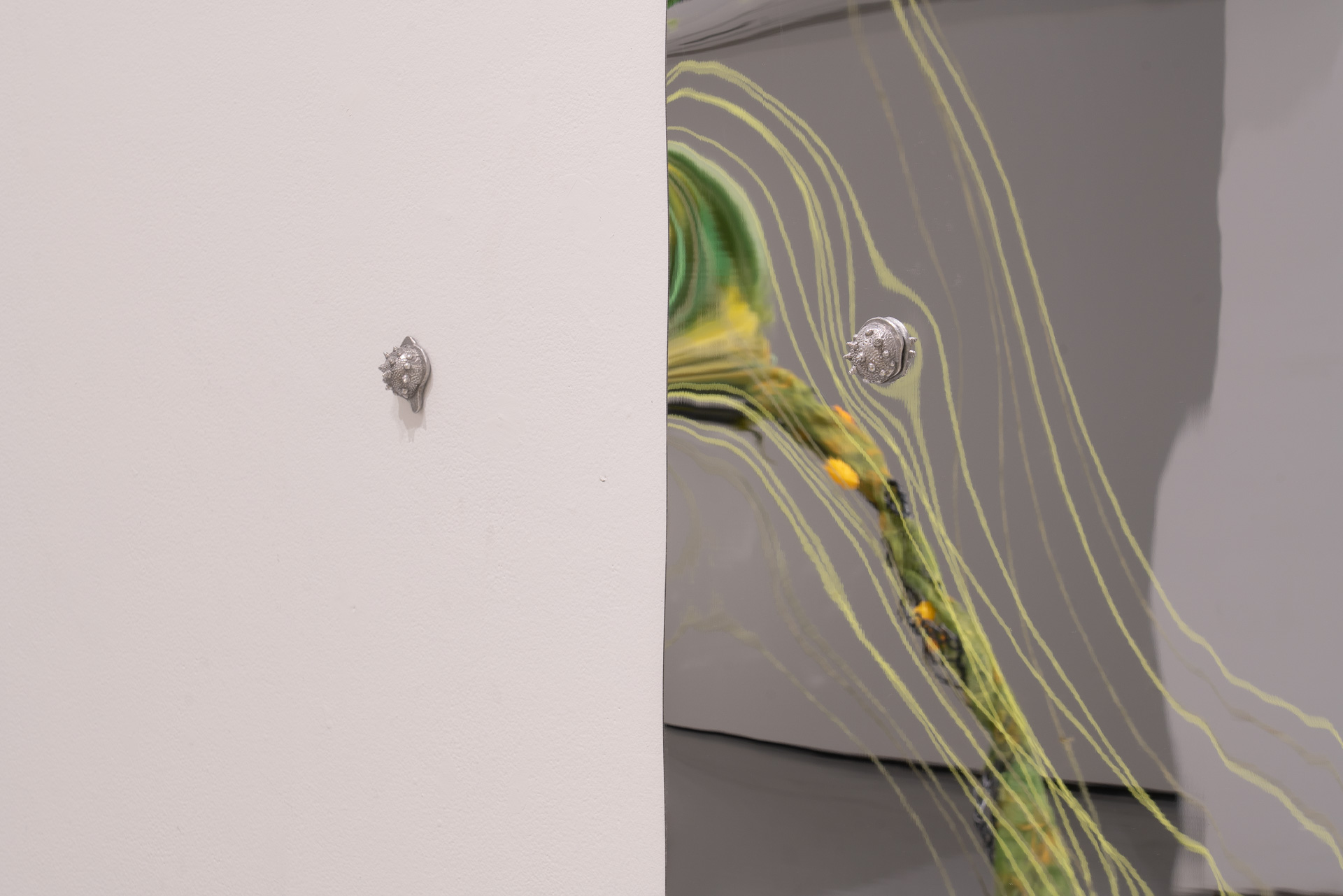
I am drawn toward the dangerous pleasure of interlaced differences in this work. It defies the unity it takes for a name or meaning to stick, and recovers the erased intimacies that undermine that rigidity. Its dimensions expand beyond an individual gaze so we have to braid our looking over The Sweetness of the Hold, Otherwise Unseen.
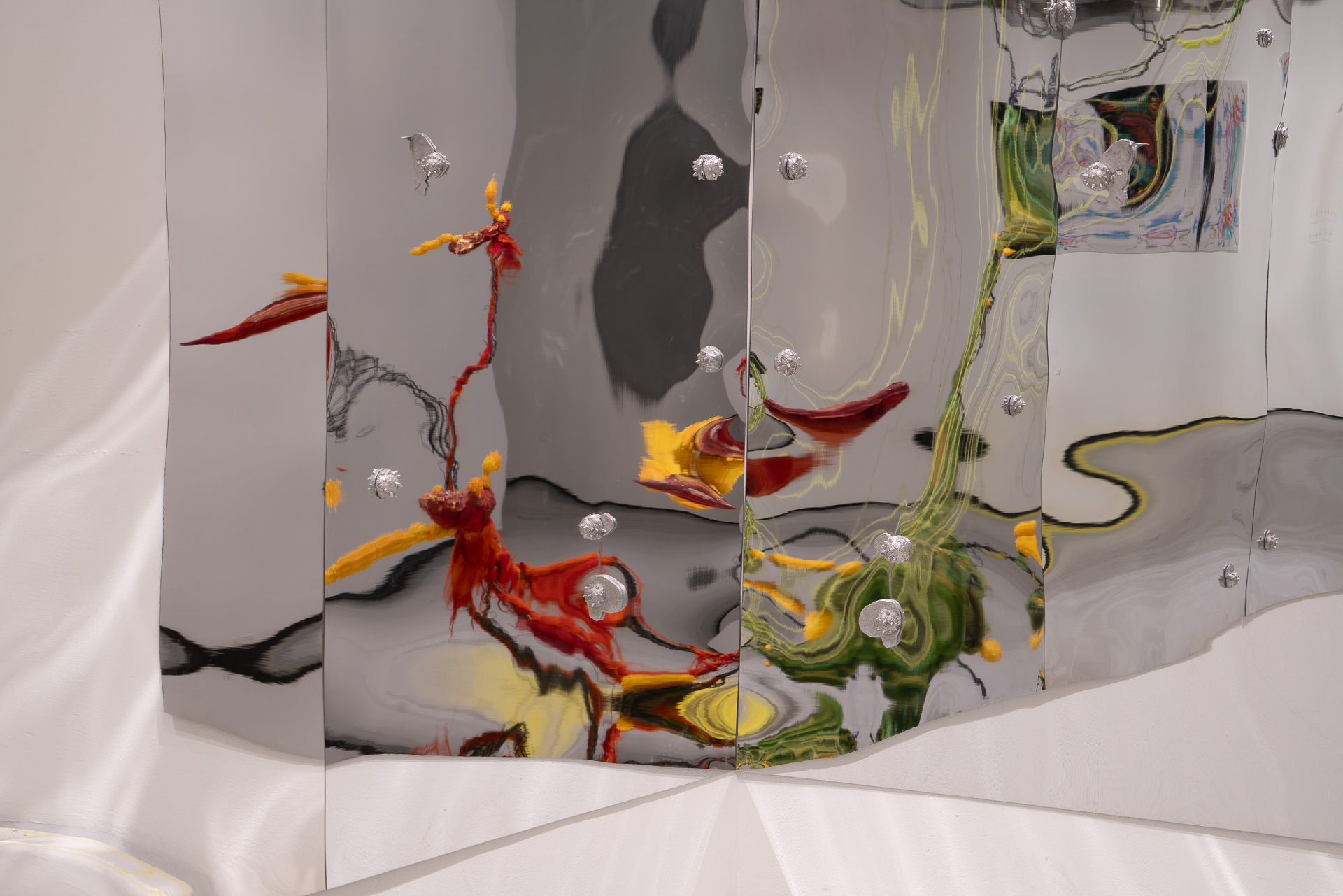
A special thank you to those who aided in the physical and conceptual manifestation of this work: Brett Ginsburg, Alex Ito, Sae Jun Kim, Desmond Lewis, Mich Miller, Peyton Peyton, Emma Safir, Edith Santiago, and Jacinda Tran.
dianaslozano.com
4 Michael Marder, Plant-Thinking: A Philosophy of Vegetal Life, pg. 13.